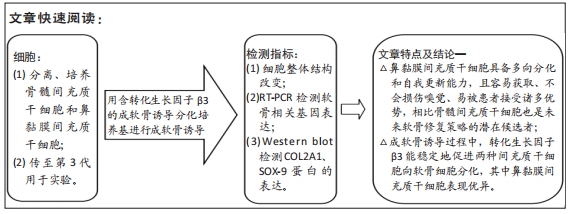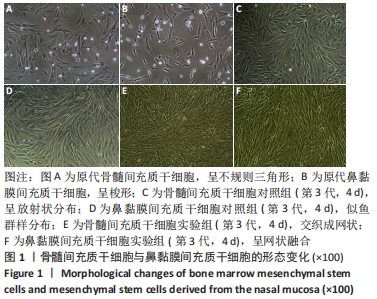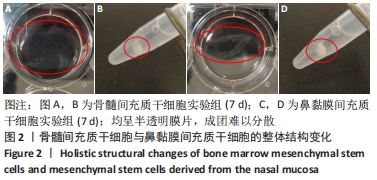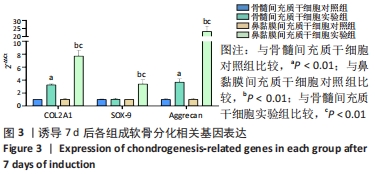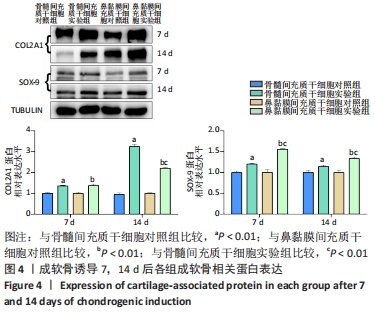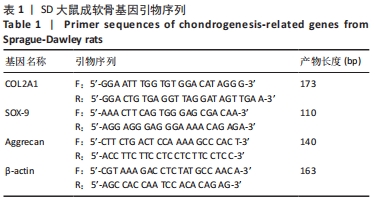[1] JIANG Y, TUAN RS. Origin and function of cartilage stem/progenitor cells in osteoarthritis. Nat Rev Rheumatol. 2015;11(4):206-212.
[2] NEOGI T. The epidemiology and impact of pain in osteoarthritis. Osteoarthritis Cartilage. 2013;21(9):1145-1153.
[3] DA SILVA MEIRELLES L, CHAGASTELLES PC, NARDI NB. Mesenchymal stem cells reside in virtually all post-natal organs and tissues. J Cell Sci. 2006;119(Pt 11):2204-2213.
[4] KIM SW, LEE IK, YUN KI, et al. Adult stem cells derived from human maxillary sinus membrane and their osteogenic differentiation. Int J Oral Maxillofac Implants. 2009;24(6):991-998.
[5] HWANG SH, PARK SH, CHOI J, et al. Characteristics of mesenchymal stem cells originating from the bilateral inferior turbinate in humans with nasal septal deviation. PLoS One. 2014;9(6):e100219.
[6] HAN C, WANG YJ, WANG YC, et al. Caveolin-1 downregulation promotes the dopaminergic neuron-like differentiation of human adipose-derived mesenchymal stem cells. Neural Regen Res. 2021; 16(4):714-720.
[7] PESTKA JM, BODE G, SALZMANN G, et al. Clinical outcome of autologous chondrocyte implantation for failed microfracture treatment of full-thickness cartilage defects of the knee joint. Am J Sports Med. 2012;40(2):325-331.
[8] CHEN FH, TUAN RS. Mesenchymal stem cells in arthritic diseases. Arthritis Res Ther. 2008;10(5):223.
[9] PITTENGER MF, MACKAY AM, BECK SC, et al. Multilineage potential of adult human mesenchymal stem cells. Science. 1999;284(5411):143-147.
[10] IM GI, SHIN YW, LEE KB. Do adipose tissue-derived mesenchymal stem cells have the same osteogenic and chondrogenic potential as bone marrow-derived cells? Osteoarthritis Cartilage. 2005;13(10):845-853.
[11] LINDSAY SL, MCCANNEY GA, WILLISON AG, et al. Multi-target approaches to CNS repair: olfactory mucosa-derived cells and heparan sulfates. Nat Rev Neurol. 2020;16(4):229-240.
[12] ZHOU F, MA D, OUYANG M, et al. Repair mechanism of mesenchymal stem cells derived from nasal mucosa in orbital fracture. Am J Transl Res. 2018;10(6):1722-1729.
[13] SHAFIEE A, KABIRI M, AHMADBEIGI N, et al. Nasal septum-derived multipotent progenitors: a potent source for stem cell-based regenerative medicine. Stem Cells Dev. 2011;20(12):2077-2091.
[14] GIRARD SD, DEVÉZE A, NIVET E, et al. Isolating nasal olfactory stem cells from rodents or humans. J Vis Exp. 2011;(54):2762.
[15] KARIMI S, BAGHER Z, NAJMODDIN N, et al. Alginate-magnetic short nanofibers 3D composite hydrogel enhances the encapsulated human olfactory mucosa stem cells bioactivity for potential nerve regeneration application. Int J Biol Macromol. 2021;167:796-806.
[16] 吕德民,史文涛,陆浩,等.组织型转谷氨酰胺酶2在鼻黏膜间充质干细胞分化过程中的表达[J].中国组织工程研究,2020,24(19): 2959-2964.
[17] QI C, XIAOFENG X, XIAOGUANG W. Effects of toll-like receptors 3 and 4 in the osteogenesis of stem cells. Stem Cells Int. 2014;2014:917168.
[18] HWANG SH, PARK SH, CHOI J, et al. Age-related characteristics of multipotent human nasal inferior turbinate-derived mesenchymal stem cells. PLoS One. 2013;8(9):e74330.
[19] GE L, JIANG M, DUAN D, et al. Secretome of Olfactory Mucosa Mesenchymal Stem Cell, a Multiple Potential Stem Cell. Stem Cells Int. 2016;2016:1243659.
[20] JOHNSTONE B, HERING TM, CAPLAN AI, et al. In vitro chondrogenesis of bone marrow-derived mesenchymal progenitor cells. Exp Cell Res. 1998;238(1):265-272.
[21] WANG W, RIGUEUR D, LYONS KM. TGFbeta signaling in cartilage development and maintenance. Birth Defects Res C Embryo Today. 2014;102(1):37-51.
[22] DUSFOUR G, MAUMUS M, CAÑADAS P, et al. Mesenchymal stem cells-derived cartilage micropellets: A relevant in vitro model for biomechanical and mechanobiological studies of cartilage growth. Mater Sci Eng C Mater Biol Appl. 2020;112:110808.
[23] SHEN H, LIN H, SUN AX, et al. Acceleration of chondrogenic differentiation of human mesenchymal stem cells by sustained growth factor release in 3D graphene oxide incorporated hydrogels. Acta Biomater. 2020;105:44-55.
[24] ZHANG H, MA X, ZHANG L, et al. The ability to form cartilage of NPMSC and BMSC in SD rats. Int J Clin Exp Med. 2015;8(4):4989-4996.
[25] AKIYAMA H, CHABOISSIER MC, MARTIN JF, et al. The transcription factor Sox9 has essential roles in successive steps of the chondrocyte differentiation pathway and is required for expression of Sox5 and Sox6. Genes Dev. 2002;16(21):2813-2828.
[26] JAYASURIYA CT, CHEN Y, LIU W, et al. The influence of tissue microenvironment on stem cell-based cartilage repair. Ann N Y Acad Sci. 2016;1383(1):21-33.
[27] LEFEBVRE V, DVIR-GINZBERG M. SOX9 and the many facets of its regulation in the chondrocyte lineage. Connect Tissue Res. 2017;58(1): 2-14.
[28] AUGELLO A, DE BARI C. The regulation of differentiation in mesenchymal stem cells. Hum Gene Ther. 2010;21(10):1226-1238.
[29] IKEGAMI D, AKIYAMA H, SUZUKI A, et al. Sox9 sustains chondrocyte survival and hypertrophy in part through Pik3ca-Akt pathways. Development. 2011;138(8):1507-1519.
[30] HATA K, TAKAHATA Y, MURAKAMI T, et al. Transcriptional Network Controlling Endochondral Ossification. J Bone Metab. 2017;24(2):75-82.
[31] BUHRMANN C, BUSCH F, SHAYAN P, et al. Sirtuin-1 (SIRT1) is required for promoting chondrogenic differentiation of mesenchymal stem cells. J Biol Chem. 2014 ;289(32):22048-22062.
[32] GONZALEZ-FERNANDEZ T, TIERNEY EG, CUNNIFFE GM, et al. Gene Delivery of TGF-β3 and BMP2 in an MSC-Laden Alginate Hydrogel for Articular Cartilage and Endochondral Bone Tissue Engineering. Tissue Eng Part A. 2016;22(9-10):776-787.
[33] CASANOVA MR, ALVES DA SILVA M, COSTA-PINTO AR, et al. Chondrogenesis-inductive nanofibrous substrate using both biological fluids and mesenchymal stem cells from an autologous source. Mater Sci Eng C Mater Biol Appl. 2019;98:1169-1178.
[34] BHARDWAJ N, DEVI D, MANDAL BB. Tissue-engineered cartilage: the crossroads of biomaterials, cells and stimulating factors. Macromol Biosci. 2015;15(2):153-182.
[35] THORP H, KIM K, KONDO M, et al. Fabrication of hyaline-like cartilage constructs using mesenchymal stem cell sheets. Sci Rep. 2020;10(1): 20869.
[36] PELTTARI K, PIPPENGER B, MUMME M, et al. Adult human neural crest-derived cells for articular cartilage repair. Sci Transl Med. 2014; 6(251):251ra119.
[37] MUMME M, BARBERO A, MIOT S, et al. Nasal chondrocyte-based engineered autologous cartilage tissue for repair of articular cartilage defects: an observational first-in-human trial. Lancet. 2016; 388(10055):1985-1994.
|
